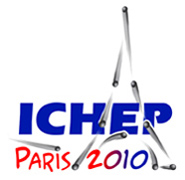Speaker
Dr
Valery The CLAS Collaboration
(Jefferson Lab)
Description
Deeply Virtual Exclusive Reactions with CLAS
Deeply virtual exclusive reactions offer an unique opportunity to study the structure of the nucleon at the parton level as one varies both the size of the probe, i.e. the photon virtuality Q^2, and the momentum transfer to the nucleon t. Such processes can reveal much more information about the structure of the nucleon than either inclusive electroproduction (Q^2 only) or elastic form factors (t=-Q^2). A dedicated experiments to study Deeply Virtual Compton Scattering (DVCS) and Deeply Virtual Meson Production (DVMP) has been carried out in Hall B at Jefferson Lab. DVCS helicity-dependent and helicity–independent cross sections, as well as beam spin asymmetry, and cross sections and asymmetries for the π0 and η exclusive electroproduction in a very wide kinematic range of Q^2, xB and t have been measured with CLAS. The preliminary data will be presented for the wide kinematic range in Q^2=1-4.5 GeV^2, xB=0.1-0.5 and t up to 2 GeV^2. We view the work presented in this report as leading into the program of the Jefferson Lab 12 GeV upgrade. The increased energy and luminosity will allow us to make the analysis at much higher Q^2 and xB and perform Rosenbluth L/T separations of the cross sections.
Exclusive electroproduction of the rho+ meson on the proton at CLAS
We will present our latest results on rho+ exclusive electroproduction on the proton measured with the CLAS detector of Jefferson Lab. We have measured for the first time ever for this process the longitudinal and transverse parts of the cross sections in the kinematic domain 0.15<x_B<0.70 and 1.5<Q^2<5 GeV2. We will discuss the interpretation of these data in terms of traditional t-channel Reggeon exchanges as well as in the latest Generalized Parton Distributions formalism. We will compare our results to the other exclusive vector meson channels measured at CLAS and in other facilities: rho, omega and phi.
DVCS Beam Spin Asymmetries with CLAS
The nucleon structure remains a fundamental question in hadronic
physics despite more than 50 years of experimental scrutiny. Its first descriptions were based on Form Factors (FFs) and Parton Distribution Functions (PDFs) accessible through elastic and deep inelastic scattering respectively. Over the past decade there has been an intense theoretical and experimental activity to unify these two approaches which ensued from the development of the Generalized Parton Distributions (GPDs). GPDs parameterize the non-perturbative content of the nucleon. Linked to both FFS and PDFs, they correlate the information in position and momentum spaces, allowing for the first time to have access to a 3-dimensional picture of the nucleon. The simplest way to measure the GPDs is through the measurement of the Virtual Compton Scattering process in the Deeply Virtual region (DVCS). This presentation will focus on the DVCS Beam Spin Asymmetry measurement performed by using data collected with the CLAS spectrometer housed in the Hall B of Jefferson Lab. The corresponding experiment was the first one dedicated to DVCS in Hall B. It took place in two separate runs, the first one in 2005 and the last in 2008-2009 with a slightly modified setup with respect to the first part. Results obtained from the 2005 experiment will be shown. A description of the recently completed second part of the experiment and corresponding preliminary results will be given as well.
Author
Dr
Valery The CLAS Collaboration
(Jefferson Lab)
